Insect & Disease Conditions Update
It’s hard to believe we have already passed the middle part of July. Despite the operational challenges our organization has faced due to the Covid-19 pandemic, Maine Forest Service Forest Health and Monitoring personnel have adapted well and have been working at full capacity doing the usual surveys and insect trapping, providing training and technical assistance both online and in some cases in person, fully equipped with all necessary personal protective equipment and with social distancing regulations fresh in mind. At this time of year, planting trees and many cultural practices like fertilization and pruning are typically discouraged, so now is a great time to scout your trees and woodlots for symptoms and signs of threats to tree and forest health. As always, you can reach us with concerns or observations about forest health online or by phone: (207) 287-2431.
With a return to an increased flow of visitors from out-of-state and more Maine people choosing to vacation within state, we would like your help in reminding people that tree-killing insects and diseases travel in and on firewood. We encourage everyone to do their part and use local or heat-treated firewood when they travel. Firewood is tied to the rapid spread of emerald ash borer and it is responsible for movement of Asian longhorned beetle, brown spruce longhorned beetle, oak wilt, spotted lanternfly, beech leaf-mining weevil and more. The reasons we know we shouldn’t move firewood are too long to detail in this bulletin. We also know that new significant forest health threats arrive steadily from other regions, at a pace of approximately one every 2.5 years. You can learn more at www.dontmovefirewood.org and www.maine.gov/firewood.

Asian longhorned beetle (Anoplophora glabripennis) – Asian longhorned beetle (ALB) has not been found in Maine. We need your help in keeping a look out for it! ALB hit the news last month when an adult beetle and associated tree damage were discovered in Hollywood, South Carolina. This detection is a good reminder that our hardwood trees and forests are vulnerable to ALB, even if we feel far removed from any infestations (the nearest known infestation is in and surrounding Worcester, MA). This time of year, activity from larvae feeding within trees would be visible around infested trees, including dripping sap and piles of coarse, wood-shaving-like frass. In addition, the showy adults would be flying if present. ALB attacks many types of hardwood trees and appears to prefer red maple in the northeast. If you suspect you have seen ALB please try to capture the beetle, at a minimum in pictures, but preferably in a sturdy container, and report it as soon as possible. You can learn more about Asian longhorned beetle and report suspected observations at www.maine.gov/alb.
Image: Asian longhorned beetle next to a penny for scale. Joe Boggs, OSU, bugwood.org
|

Balsam Fir Sawfly (Neodiprion abietis) – District forester Terri Coolong responded to a report of scattered dead conifers on a woodlot in Lincoln, Penobscot County. On site she found scattered dead balsam fir and on a live fir, aggregations of balsam fir sawfly larvae. This is an insect that is not reported to our office very frequently (no reports in 26 years of data).
Balsam fir sawfly is a native insect that sometimes has short duration outbreaks. Unlike many other defoliators of fir, larvae feed preferentially on the older foliage, leaving the current year foliage intact.
The last localized outbreak recorded in Maine was in 1992–1993, with defoliation seen in coastal pockets from Jonesport to Milbridge. Prior to that, there was an outbreak of this insect in coastal regions from Portland to Rockland in the 1940’s. At the time of the 1992–1993 outbreak there was a concurrent outbreak of hemlock looper which also feeds on fir. The trees impacted by sawfly could be readily told from those impacted by looper based on the presence of healthy, green current-year growth on defoliated trees.
On Christmas tree farms and in other settings where this defoliation is unacceptable, balsam fir sawfly can be managed with an appropriate contact or stomach insecticide when large numbers of the larvae are detected. Scouting for larvae should start in the latter part of June. Because this is a sawfly, products with the active ingredient BtK will not be effective for management.
The fir mortality that prompted this discovery did not appear to relate to the sawfly presence but was likely due to moisture stress. The site was ledgy, and as reported in the disease portion of this bulletin, parts of Maine have experienced several years with significant periods of scarce moisture.
Image: Messy feeding on older fir foliage is characteristic of balsam fir sawfly damage. The larvae have dark heads and dark, longitudinal stripes on their bodies. MFS, T. Coolong
|
Birch and Beech Girdler (Xylotrechus quadrimaculatus) – A report of distal ends of beech twigs dropping to the ground in Litchfield (Kennebec County) is suspected to be caused by the birch and beech girdler. The office fields frequent reports of similar damage in oak from the oak twig pruner (see below), but as with the balsam fir sawfly, in 26 years of data this was the first record of birch and beech girdler, an insect native to this area.
This species is also found on birch, maple, hornbeam, and alder. The damage is probably best described in the emailed report: “…when we looked closely at the end of the branch, we see larvae which have tunneled through the branch (across it), weakening the branch until a wind comes by and snaps it off. The larvae are small, under 1/8" wide, and pale.” The severed end is cleanly cut except the bark and a small portion of the center. The damage does not significantly impact the health of the tree. Infestations may be reduced by cleaning up and destroying the fallen branch ends. The adult is a striking longhorned beetle, pictures can be seen on bugguide.net.
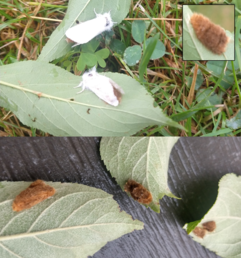
Browntail Moth (Euproctis chrysorrhoea) – Browntail moth (BTM) pupation had occurred at all monitoring sites by June 26, first pupation was noted the week of June 15. Adult BTM had begun to appear at all monitoring sites from Old Town south to Portland and west to Turner in the first week of July.
We recommend limiting outdoor lighting always, but especially during BTM flight period through the end of July/early August. Flight is concentrated during the hours of 10pm to midnight. Winter webs (therefore summer egg masses, and the source of spring discomfort) are often found concentrated in trees near outdoor lighting. Anecdotal evidence suggests more males come directly to lights than females, with the females spending time on host foliage near the lights. For this reason, among others, bug zappers and homemade light traps are not effective in controlling BTM. Additionally, these systems are non-selective and kill many beneficial insects including those that attack BTM and other insect pests.
Egg-laying was observed in Manchester on July 14. Where eggs are observed, the leaves or egg masses may be removed and destroyed or soaked in soapy water. Although control of the early feeding larvae which will hatch in August is possible, it is often difficult to tell which hosts are impacted before the most effective window for management is closed.
Image: (top) Female browntail moths depositing eggs; (inset and bottom) Egg masses of browntail moth, eggs are covered with the setae (hairs) from the adult female’s abdomen.
|
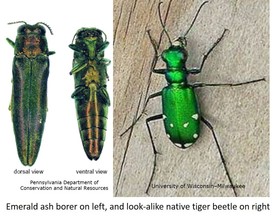
Emerald Ash Borer (Agrilus plannipennis) – According to the latest degree-day map for emerald ash borer (EAB), adult beetles will have emerged throughout the state (a degree-day model looks at the accumulated heat during the season and uses this to predict the development of insects). Now is the time to watch for adult EAB. The look-alike six-spotted tiger beetle is also present during the summer months. It is the same brilliant metallic green as EAB and roughly the same size, although it has a broader shape and is very frequently mistaken for EAB (note that the white spots on the tiger beetle are not always as obvious as in the picture shown).
One of the easier ways for a non-entomologist to distinguish between the two is by their behavior. EAB adults are most likely to be seen on or near ash trees and will rarely be seen sitting on the ground. Tiger beetles, however, are frequently seen on the ground. They are very active hunters, and often hard to capture. If you walk toward them, they usually jump up and fly away 15 feet or so. If you continue to approach them, they will fly off a short distance again. If you observe this behavior in a brilliant green beetle, you can be fairly safe in assuming it is a tiger beetle and not EAB. However, as always, if you can take a picture of what you see, you can send it to us for verification.
In our ongoing search for EAB, Maine Forest Service field staff will now begin the important task of servicing the 200 purple prism traps hanging statewide to replace lures and inspect them for any adult EAB beetles. We’ll keep our fingers crossed as always that all traps come back negative, but positive traps will provide valuable information on new infestations located outside the Maine’s EAB quarantine area. Results of this mid-season trap check should be available in August.
Images: (left) EAB adult beetles; (right) A native tiger beetle. PA Department of Conservation and Natural Resources; University of Wisconsin Milwaukee
|
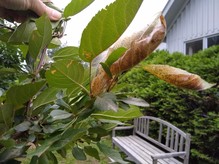
Fall Webworm (Hyphantria cunea) – Fall webworm feeding is becoming apparent. Eggs are deposited on the underside of host leaves in late-June or early July. When the caterpillars hatch, they begin to skeletonize the leaves and create their characteristic webs. Most folks notice the webs after they are well developed. Damage from this native insect does not significantly impact the long-term health of the host. Think of it as food to support generalist predators and parasitoids important in suppressing other significant pest populations. This is a good time of year to relocate or destroy webs developing in locations that are of aesthetic concern. A forked stick or a stick with a nail in it may be inserted into larger webs and by twisting it the loose webs may be pulled from the trees.
Image: Early feeding damage and webbing from fall webworm caterpillars in crabapple.
|

Gypsy Moth (Lymantria dispar) – Maine has enjoyed relative quiet in terms of gypsy moth caterpillar activity in recent years, however reports of mature caterpillars are now coming in at greater frequency this season compared to last. Damage may be noticeable in some locations but remains limited to our knowledge, including at regularly monitored locations that tend to maintain healthy populations of gypsy moth year after year. Some recent calls have come from new and unexpected locations and given the widespread distribution of these reports, ranging from Oxford to Aroostook counties and most counties in between, could begin to represent a statewide trend of increasing populations.
Gypsy moth is a cyclical pest that returns roughly every ten years and the last time Maine experienced anything resembling an outbreak was the early 2000s, where some 51.5 thousand acres were affected. Prior to that, massive outbreaks in both the early 1980s and 1990s both left more than half a million acres affected. It’s still too early to predict, but perhaps the current uptick in reports means that our luck has finally run out after escaping any major damage when we would have expected an outbreak about a decade ago.
Another possible explanation for the increased numbers of caterpillars in 2020 is the weather. Population control of gypsy moth is closely tied to spring weather conditions and whether or not cool temperatures and abundant moisture create conditions favorable for the spread of entomopathogens that kill caterpillars. One interesting observation in recent weeks is seeing oak stands that are co-inhabited and have been concurrently defoliated by browntail moth and gypsy moth. Since populations of both gypsy moth and browntail moth are regulated by many of the same environmental conditions, it’s likely that both insects experienced very low disease loads in 2020 due to prolonged dryness and therefore escaped high levels of mortality.
We have received a report earlier this week and accompanying photo of caterpillars likely afflicted by the fungal pathogen Entomophaga maimaiga from Eddington (Penobscot County). The forester reported many large caterpillars on the oaks hanging immobile, head down and filled with “brown goo.” Although the caterpillars were numerous, there was not obvious defoliation.
Mature gypsy moth caterpillars can be easily identified at this time of year by the five pairs of blue spots followed by six pairs of red spots on their backs. Although most caterpillars have reached full maturity at this point and the majority of feeding damage has been done for 2020, we encourage continued reports of large populations or defoliated areas in the event we can add new sites to our egg mass survey conducted during the fall and winter months.
Image: Overhead panorama of defoliation in an oak stand within Frye Mountain WMA (Waldo County), first caused primarily by earlier feeding browntail moth caterpillars and now experiencing some additional secondary defoliation due to gypsy moth caterpillars somewhat later to mature.
|
Oak Twig Pruner (Anelaphus parallelus) – We have received single report of oak twig pruner this year (Fryeburg, Oxford County), but expect more will come in. This insect requires two years to develop from egg to adult, and it is generally in the even years that we receive reports of oak twigs scattered on the ground resulting from larval feeding activity. Often these branches still have green leaves attached when they fall, sometimes the leaves will have dried and reddened before the twig is completely severed. As with the birch and beech girdler, the severed end is cleanly cut (in contrast to squirrel damage, for instance). Oak twig pruner damage is generally inconsequential from the standpoint of tree health. Cleaning up and destroying fallen branches may help limit infestations and should be done thoroughly and some distance from the tree(s) you are trying to protect.
Spruce Budworm (Choristoneura fumiferana) – By now, even in the northernmost reaches of the state, the majority of spruce budworm larvae have pupated and are emerging as adult moths. For this year, any damage caused by larval feeding is complete and only the evidence might still be left behind. The bulk of feeding evidence has likely been washed away by frequent, heavy storms over the past several weeks, and so the chances of observing it are now reduced. We have yet to perform aerial survey in the areas where we’ve observed some larval feeding damage from the ground, but for now damage remains minor enough that it is doubtful it will be visible from the air.
Now we enter a waiting period until we have more information available on the 2020 spruce budworm situation in Maine. Our network of about 350 pheromone traps is undoubtedly capturing moths around the state, however it remains to be seen exactly where the largest number of moths will be collected. We know from monitoring Canadian SBW flight models that as of now, the influx of moths into Maine from outbreak areas in Quebec has been limited in 2020 (see map). That could still change, but if not, we can infer that the vast majority of moths captured in our traps represent those from populations that have completed their entire life cycle right here in Maine.
Also, of even greater importance in 2020 will be surveys for overwintering SBW larvae (L2s). These surveys will be performed during the fall and winter months, and unlike pheromone traps that can potentially capture adult moths from other far away areas, provide a better representation of local populations. Data from the 2019 L2 survey has already showed us a slight increase in larval numbers and the areas with the highest 2019 L2 counts are those where we’ve seen some increased larval feeding damage in 2020. Populations in Maine still remain below management thresholds; however, it is becoming more and more important to be prepared for an appropriate management response in the upcoming years should populations continue to increase.
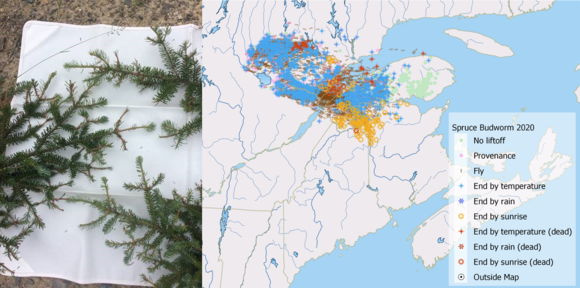 Example of 2020 spruce budworm defoliation seen on branch samples collected from Big 20 township this week. Note that weather conditions have caused the loss of tell-tale webbing containing clipped needles on the branch tips, meaning missing needles are the only visible evidence of spruce budworm feeding that remain in some locations; (right) Model of spruce budworm atmospheric transport. MFS; Canadian Forest Service
Ugly-nest Caterpillar (Archips cerasivorana) – After our last bulletin came out detailing Euonymus caterpillar infestations around the state, Gordon Mott provided us with a report of ugly-nest caterpillars in Lee (Penobscot County). This species can also produce spectacular webbing, and they are having a good year in Lee. Gordon relayed that in the 1950’s he reared the parasitoid Glypta fumiferanae from this species, a parasitoid that also includes spruce budworm in its diet. He reported observation of adult eclosion (emergence) on July 6, 2020, around the same time adult spruce budworm were emerging in Maine. The Ugly-nest caterpillar’s preferred hosts are cherries (the species name translates to cherry-eater per bugguide.net), but it will feed on other hardwood trees and shrubs. Feeding does not have long-lasting impacts on the hosts, and management is generally not required. In ornamental trees and shrubs, through careful observation, web development can be interrupted early in the season to prevent aesthetic damage. More on this species is available online.
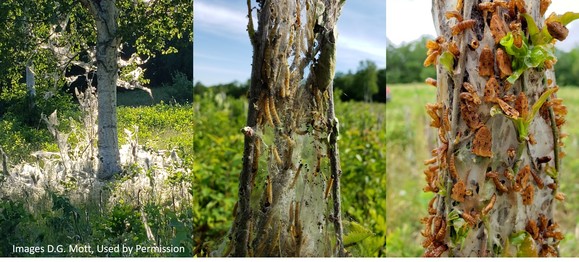 (left) Webs created by ugly-nest caterpillar on pin cherry and white birch in Lee, ME; (center) Close up of ugly-next caterpillars and webbing; (right) Adults and pupae of ugly-nest caterpillar moth. D.G. Mott, used by permission
Abnormally Dry and Drought Conditions
Maine has experienced abnormally dry and drought conditions throughout part of May and into July across most of the state. In Northeastern Aroostook County, conditions have developed to severe drought.This has resulted in a number of reports of tree disorders including associated mortality and leaf drop. Trees with predisposing stressors and trees that are not yet fully established may have the most difficulty coping with the lack of water. While some symptoms have been immediately obvious, other symptoms may come later, even after the recent rise in rainfall totals in some parts of the state. As referred to later in this section of the report, drought can be a significant primary stressor, leaving trees more vulnerable to secondary agents of decline.
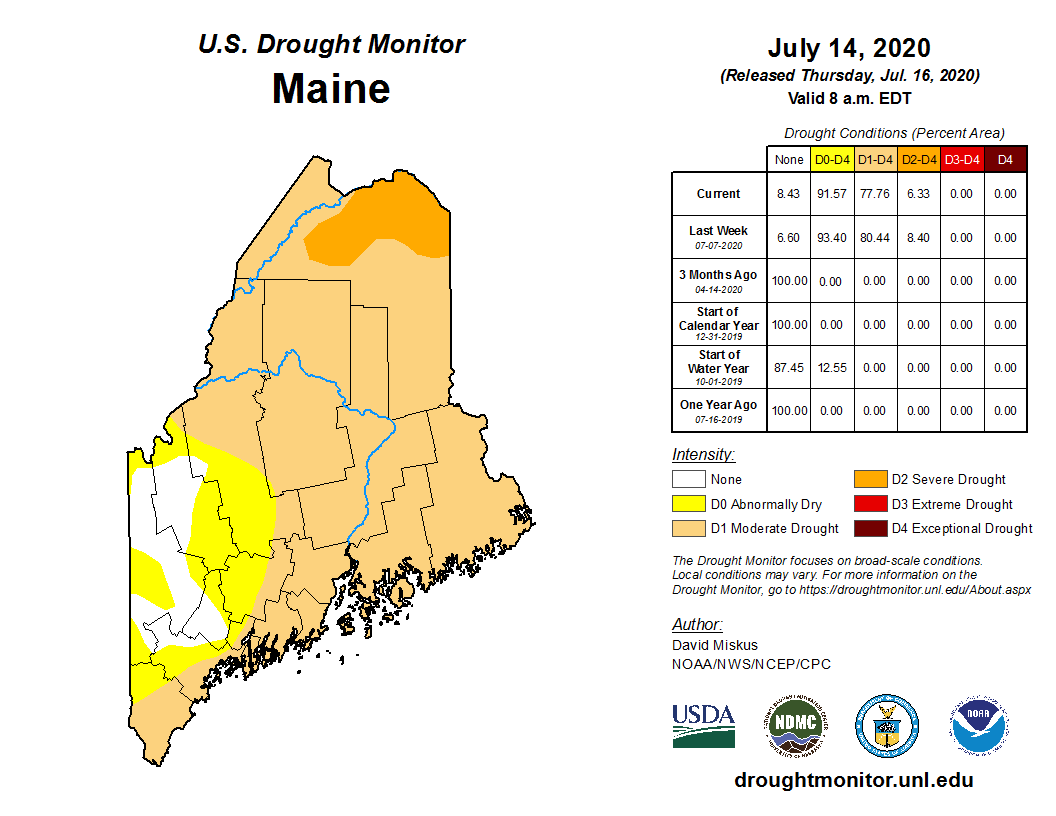 Image: July 14 drought monitor map. NOAA, https://droughtmonitor.unl.edu/Maps/MapArchive.aspx
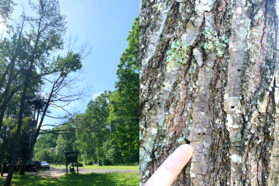
Dead Oaks in Portland
The Maine Forest Service forest pathologist and forest health technicians recently visited several sites in the Portland area to evaluate the reason for the mortality of oak trees reported by the City of Portland Forestry Department and a local nursery. The cause for greater concern than usual is the threat of oak wilt disease, which has not been found in Maine, but is a focus of early detection efforts. Fortunately, the reason for the oak mortality was not oak wilt.
Instead, a similar set of symptoms was seen at all the sites visited. The oak trees had numerous D-shaped exit holes all over the main stem. These holes are very likely made by the two-lined chestnut borer, a common pest of stressed oak trees. Even though the feeding on the cambium by the borer larvae prior to their emergence played a large part in the trees’ final demise, other stressors were likely what started the spiral of decline eventually leading to tree death. Such stressors include drought and site manipulation, both of which adversely impacted the evaluated oak trees. The impacted trees at one of the sites were growing next to a sidewalk that was recently renovated, which involved digging in the root zone and injury to roots. Another dead oak was in an area of high human traffic where soil compaction seemed to be a factor, while another dead oak had a large basal scar from an injury. All of the dead oaks had an additional significant stressor in common: water deficit.
For the past three years – including late May and June of this year – the southern part of Maine has experienced prolonged periods of very dry weather. Stress from water deficit is one of several factors that has been shown to increase susceptibility to borer attack. In summary, in these cases tree mortality has been a process that started in earlier times, not an event that happened at a recent specific point in time. When trees experience an initial significant stress – or a chronic stress – they become more susceptible to secondary agents of decline. While we cannot control weather-related and other natural stressors, this highlights the importance of cultural practices that avoid injuring trees and maintaining tree vigor.
In closing, to help the MFS in their oak wilt early detection efforts, please report all instances of unexplained oak mortality and any premature defoliation and/or wilting of oak foliage. If oak wilt disease does arrive in Maine, and we catch it early, we will be better able to manage it. All oak wilt inquiries can be directed to aaron.bergdahl@maine.gov, (207) 287-3008.
Images: (left) The silhouette of a dead oak tree in a high human traffic area; (right) The D-shaped exit holes left by the emergence of adult two-line chestnut borers.
|

Dutch Elm Disease (Ophiostoma ulmi, Ophiostoma novo-ulmi) – Reports of Dutch elm disease (DED) have been on the rise throughout Maine in late June to mid-July. Symptoms include discoloration of leaves, early defoliation and wilting branches/sections of trees, or even wilting and death of whole trees if the disease was transferred from an infected tree to a neighboring tree via underground root grafts. Typically, younger trees are not affected, although DED was confirmed on a less than 10-year-old tree in Manchester in early July. Despite the devastation of the American elm population via DED, there are still many American elm trees on the landscape throughout Maine. There are even mature American elm trees that have seemed to escape infection – or maybe they have some level of genetic resistance. The US Forest Service is trying to track large healthy “survivor” elms via an online fillable form. The user-friendly form allows you to locate the tree on a mapping application and add information about the tree for future reference. Maybe with your help, American elms with genetic resistance to DED can be identified and used to bring back this beautiful and iconic tree species.
Image: A elm tree dying from Dutch elm disease, flanked by already deceased elm trees that possibly infected the rapidly declining tree via underground root connections.
|
Wednesdays July 22 thru August 26, 3-4pm – 2020 New Hampshire Forest Health Webinar Series. The pests and pathogens impacting New Hampshire do not recognize the state boundary lines. Tune in to this informative series to learn more about forest health issues. The webinar series is organized by the NH Division of Forests and Lands and UNH Extension.
July 30, 2020, 5-6pm – In collaboration with Bangor Daily News (BDN), Michael Parisio will participate in an online event to discuss invasive threats to Maine Forests. Mike will join Jesse Wheeler Vegetation Program Manager at Acadia National Park and BDN host Melanie Brooks. Find information and register online.
Office hours are 7:30 am to 4:00 pm, Monday through Friday, except for holidays. However, we are currently working remotely and DACF buildings are closed to public access. You can still reach us at: (207) 287-2431. Status of the building closure will be updated on the DACF homepage.
NOTE: The Augusta office is now housed in the Deering Building, 90 Blossom Lane, Suite 201. The mailing address and phone numbers are unchanged. A map is available on our website. The lab at 50 Hospital Street is currently housing the Kennebec County Soil and Water Conservation District.
Conditions Report No. 4, 2020
On-line: https://www.maine.gov/dacf/mfs/publications/condition_reports.html
Department of Agriculture Conservation & Forestry
Maine Forest Service – Forest Health and Monitoring
Contributors: Aaron Bergdahl, Joe Bither, Allison Kanoti, Mike Parisio, Thomas Schmeelk, Regina Smith and Colleen Teerling
Unless otherwise noted, photos by Maine Forest Service, Forest Health and Monitoring, DACF
|